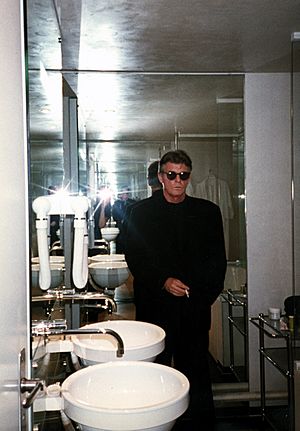Lewis Baltz facts for kids
Quick facts for kids
Lewis Baltz
|
|
|---|---|

Lewis Baltz (1998) in Jean Nouvel's Amat hotel
|
|
| Born | September 12, 1945 |
| Died | November 22, 2014 (aged 69) Paris, France
|
| Education | San Francisco Art Institute Claremont Graduate School |
| Occupation | Visual artist, photographer, educator |
| Known for | New Topography |
Lewis "Duke" Baltz (born September 12, 1945 – died November 22, 2014) was an American artist, photographer, and teacher. He was a very important person in the New Topographics movement in the late 1970s. This was a style of photography that showed ordinary, often overlooked landscapes.
Baltz was best known for his black-and-white photos of suburban areas and industrial parks. His pictures often showed what he felt was missing from the "American Dream". He also wrote for many magazines, including L'Architecture d'Aujourd'hui.
His artworks are kept in major museums around the world. These include the Solomon R. Guggenheim Museum and the Metropolitan Museum of Art.
Contents
Lewis Baltz: Early Life and Education
Lewis Baltz was born on September 12, 1945, in Newport Beach, California. His father passed away when Lewis was 11 years old.
He studied Fine Arts at the San Francisco Art Institute, graduating in 1969. He also earned a Master of Fine Arts degree from Claremont Graduate School. This school is now known as Claremont Graduate University.
His Photography Career and Style
Baltz's art often looked for beauty in places that seemed empty or broken. His photos showed the buildings and spaces humans create, like offices, factories, and parking lots. He believed his pictures showed how people control and are controlled by their surroundings.
In 1974, he created a famous series called The New Industrial Parks near Irvine, California. This work explored how people lived in and used these new, often plain, industrial areas.
His photo books and exhibitions, like The New Industrial Parks and Candlestick Point, explored how technology affects our world. His series Candlestick Point included 84 photos. These pictures showed a public space near Candlestick Park that was changed by both nature and human actions.
In the late 1980s, Baltz moved to Europe. He then started to use large, colorful prints in his work. He published several books of his photos, such as Geschichten von Verlangen und Macht. Another series, Sites of Technology (1989–92), showed the very clean insides of high-tech factories and research centers. In 1995, he created Deaths in Newport as both a book and a CD-ROM. Baltz also made some video artworks.
He taught photography at many schools. These included Claremont Graduate University, California Institute of the Arts (CalArts), and the Università Iuav di Venezia in Italy. In 2006, he helped start the Arsenale Institute for Politics of Representation in Venice.
Later Life and Legacy
In 2002, Lewis Baltz became a Professor of Photography at the European Graduate School in Saas-Fee, Switzerland. He spent his last years living between Paris and Venice.
Lewis Baltz passed away on November 22, 2014, in Paris. He was 69 years old and had been ill for a long time. His unique way of photographing landscapes left a lasting impact on the art world.
Awards and Achievements
Lewis Baltz received several important awards and scholarships for his work:
- National Endowment For the Arts scholarship (1973, 1977)
- John Simon Guggenheim Memorial Fellowship (1977)
- US-UK Bicentennial Exchange Fellowship (1980)
- Charles Brett Memorial Award (1991)
Where His Work is Kept
Lewis Baltz's photographs are part of the permanent collections in these museums:
- Solomon R. Guggenheim Museum
- Metropolitan Museum of Art
- Tate Modern
- Los Angeles County Museum of Art
- Whitney Museum of American Art
- Art Institute of Chicago
- Museum of Contemporary Art San Diego
- Philadelphia Museum of Art
- San Francisco Museum of Modern Art
See also
 In Spanish: Lewis Baltz para niños
In Spanish: Lewis Baltz para niños

